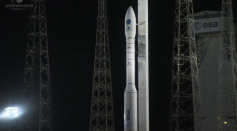Tags: Satellites

SpaceX Nailed Rocket Landing After Sending Massive Radio Satellite to Sirius XM
Rocket Start-Up Aevum's Drone Ready To Take Satellites Into Orbit
ULA Forced To Abort Spy Sat Launch Again, This Time Due to a Sensor Fault

Northrop Grumman Earns Contract for Space Force's ESS Program

Vega Rocket Returns To Service, Carries 53 Satellites To Orbit

SpaceX to Launch Satellites Into Polar Orbit & Continue the Starlink Mission
SpaceX to Launch Its First 60 Internet-Providing Satellites
New Satellites Pinpoint Greenhouse Emissions on Earth
NASA Satellite Goes Quiet After Breakthrough
SpaceX Reportedly Will Launch Thousands Of Internet Satellites; Falcon Heavy’s Main Core Made Its First Static Fire Test
Future Moon Orbiting CubeSat Prototype Being Tested Already By Estonia, Slated To Launch In 2019
NASA Awarded Atlas V Rocket To Launch The Next Weather Satellite: NOAA Budget Reportedly Under Threat
India vs China: Which Country Has Better Space Advancements
Another Falcon 9 Launch—Will This One Be Different?
VIDEO—NASA’s Satellite Space Fleet Path Patterns Revealed
Military Satellite Explodes in Space
SpaceX Launches Two New Electric Satellites
Navy Launches New Communications Satellite
Elon Musk Continues to Dream Big with Idea for Space Internet
NASA and NOAA Support the Development of Two New Climate Tracking Apps
Most Popular

Microplastics Are Everywhere — How Plastic Pollution Threatens Wildlife, Soil, and Water

Brain Health Aging Guide: Effective Strategies for Cognitive Decline Prevention and Lower Dementia Risk

Mitochondrial Health and Aging: How Cell Energy Drives Modern Anti-Aging Science

How Scientists Use Radio Telescopes to Search for Alien Signals Across the Universe





